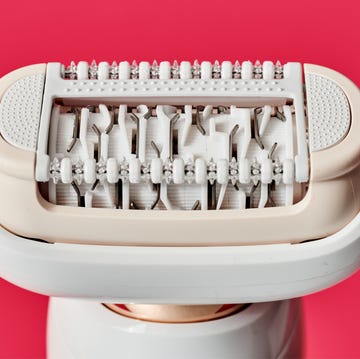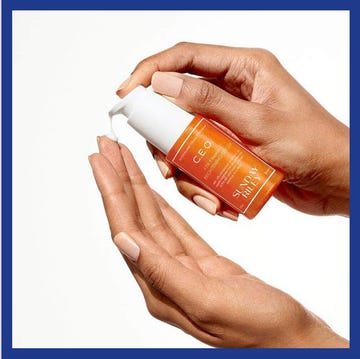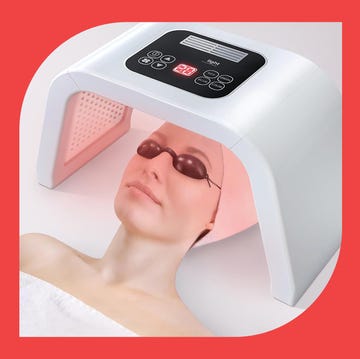Odds are you've heard the scary stats: Skin cancer is the most common form of cancer in the U.S., with more cases diagnosed each year than breast, prostate, lung, and colon cancer combined, according to the Skin Cancer Foundation. And before you brush this off as an old person's problem, you should know that melanoma—the deadliest form of skin cancer—is the number one cancer in adults between the ages of 25 to 29.
While facts like this might inspire you to slather on the SPF and stay away from tanning beds, there's also something else you can do: Go to your dermatologist for annual skin cancer screenings. "There is a lot of new technology that dermatologists are using that adds an artificial intelligence component to these exams, helping us detect skin cancer earlier than ever," says Jerry D. Brewer, M.D., vice-chair of the dermatology research unit and assistant professor of dermatology at the Mayo Clinic College of Medicine. And the earlier you or your derm sees a suspicious-looking spot, the better your prognosis will be if it is skin cancer.
Ask your doctor about the following new technologies used to spot skin cancer early, and find out if one of them might be right for you:
1. Total Body Photography: While your dermatologist will likely take photos of your moles during your appointment so she has a reference for the next time you see her (moles that grow, get darker, or morph into a different shape could be a sign that they're atypical), she might also recommend total body photography.
How it works: This procedure requires you to go to a medical photography studio to have photos taken of every part of your body. These high-definition images will then help your derm see clearly which moles are changing—and which ones might be new. Intrigued? You can read about my experience with it here: I Did a Naked Photo Shoot—For My Health!
"This procedure is especially beneficial for patients who have more than 100 moles," says New York City dermatologist Julie Karen, M.D. While you might not be so excited about having a series of extremely high-def naked photos of yourself taken, Brewer says that in addition to helping your doctor, they can also help you do skin cancer self-exams. "These photos can really help you see new or changing moles when you're looking at your own skin, because they document all of your skin—your moles and also the rest of your skin that doesn't currently have moles," he says. "Once you hit your mid-30s and early 40s, you really shouldn't be growing any new moles, so total body photography can give you a thorough comparison point to help you spot new moles that pop up."
2. Dermoscopy: This handheld microscope of sorts is the little gadget-like device that your dermatologist holds up to your moles to look at them more closely.
How it works: A dermoscope combines high magnification and high light intensity so that your dermatologist can see diagnostic features of your moles that couldn't otherwise be seen with the naked eye. Research shows this technique has been clinically proven to be significantly more accurate in diagnosing cancerous moles than the naked eye alone. Both Brewer and Karen use dermoscopy routinely in their practices. "Dermoscopy has been shown to improve the accuracy of knowing which moles need to be biopsied," says Brewer. "It gets rid of a lot of unnecessary procedures, and it can also confirm that a spot is concerning and needs to be biopsied."
MORE: What's Your Skin Cancer Risk?
3. MoleSafe: This combines total body photography with dermoscopy and dermoscopic photos to identify suspicious-looking lesions, says Karen. "Like total body photography, it is very useful for patients with personal and or family history of melanoma, as well as patients with many moles," she says.
How it works: Your dermatologist will look at your moles through a dermascope, then compare them to a total body photography "map" of your moles to monitor any new or changing lesions. Your doc might also use a special camera with a lens that actually turns into a dermoscope, which is like taking a picture of the microscopic elements of your mole. This multi-approach, sequential monitoring of your skin is particularly useful when it comes to identifying melanoma at an early stage, as it is much more effective at picking up a potential melanoma than if your derm was just looking at your skin during a routine, point-in-time skin exam. "If you can catch a change in a mole early enough—even changes happening at the microscopic level—that is the key," says Brewer. Find out more at MoleSafe.com.
4. MelaFind. This FDA-approved device is a non-invasive way to analyze moles and help your dermatologist determine which ones may be melanoma.
How it works: First, your doc will take a picture of your mole with a special camera. Then, that photo gets beamed into the MelaFind machine and compared to a database of thousands of images of melanoma lesions. The machine then assigns the picture of your mole a number on a scale of potential melanoma, perhaps prompting your doctor to biopsy that mole if it receives a high enough number.
MORE: The Tanning Bed-Melanoma Connection
"This is a pretty cool tool that's gotten a lot of good reviews, but it's also received criticism from biostatisticians," says Brewer. That's because there are a lot of false positives. "The machine is super sensitive," says Bewer, which means it might designate a mole high on the melanoma scale even though your derm has been monitoring it and there's been no change, leading to more frequent biopsies of benign moles. Find out more at MelaFind.com.
5. Tape stripping: This is a new technology that isn't widely available yet, but may be seen more frequently in dermatologist offices in the future, says Brewer.
How it works: A dermatologist applies a strip of tape over a suspicious-looking mole and then takes it off—similar to ripping off a bandage—and analyzes the DNA in the skin sample. This method actually provides enough DNA to analyze the mole and decide whether or not the mole is melanoma. "Dermatologists have been playing around with this for three to four years, and I believe it might be more prevalent when DNA analysis is more advanced," says Brewer. "If there was a machine in every dermatologist's exam room that could analyze a mole in real time, I think it would really take off." Currently, tape stripping isn't a common practice because dermatologists who are using the new technology have to send the DNA samples to a lab, and there are minimal labs that do DNA analysis.
MORE: Sunscreen May Not Be Enough to Protect Against Melanoma













